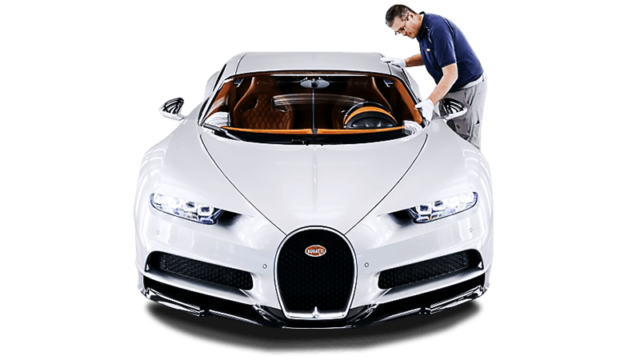Bugatti has a spellbinding façon of building cars
























Two months. 20 employees. 1,800 components. And other 32 logistics and quality check staff are the life Bugatti breathes into the Chiron.
Bugatti calls their 1,000 square-meter Molsheim plant Atelier. Call them posh, but it's for a good reason. The floors are squeaky clean, and every pair of hands working on the Veyron's successor is a bright example of craftsmanship.

The carmaker's target for 2017 is 70 Chiron models, and for that to happen, Bugatti had to retool the Molsheim facility so that it could be up to the task. However, you won't see conveyor belts or robots. Everything gets done by hand.

Under normal circumstances, a Chiron needs nine months between configuration and delivery. That's why at the time of writing, Bugatti staff are working in parallel to mold no less than 12 Chirons.
“We are building a super sports car. That is quite clear.”
Christophe Piochon, Member of the Bugatti Board of Management, responsible for Production and Logistics.
Once a customer signs off the final configuration, an octopus of processes and procedures is triggered. The 1,500-horsepower engine tipping the scales at 628 kilograms comes pre-assembled from the VW Group plant in Salzgitter.

It is then intensively bench-tested for eight hours. The seven-speed, dual clutch transmission undergoes the same treatment, as it will have to deal with 1,600 Nm of torque. To pull that off, it got bigger and more complex.
Before meeting the engine, the chassis spends one week in assembly. The rear end is separately built around the powertrain.

Only then "the marriage happens" – binding together the monocoque and the rear end through 18 titanium bolts with a weight of 34 grams each. Weight saving was crucial for the new Chiron.
Fun fact #1: Chiron's engine is no heavier than the Veyron's, but it has 300 extra horsepower.
The next step involves a rolling dyno – the most powerful of this type in the world. In fact, it's so powerful that Bugatti reroutes the excess power to the local grid in Molsheim.

Once strapped and secured on the dyno, the Chiron will go through simulated speeds of 200 km/h and acceleration sessions under full power for two to three hours, enough to cover the better part of 60 kilometers. The mechanic behind the wheel monitors engine settings and the engine-transmission collabo, but also safety features like ABS and ESC.

There's even a water test the Chiron has to pass as it withstands 30 minutes of monsoon rain that would expose potential leaks.
Fun fact #2: For its final test and inspection drive, Bugatti wraps the Chiron in a protective transparent plastic foil. The process takes a whole day. A further day is needed to remove the foil once the test drive is over.
Speaking of which, the test drive itself is more of a road trip as the Chiron travels 300 km to Colmar airport, where it uses the runway to sprint to 250 km/h. The trip back serves as the cooldown.

During this time, the customer makes several visits to the Molsheim facility, and for those eager to participate in the building of their car, Bugatti offers a full working day in the Atelier.
